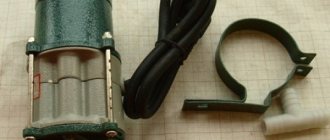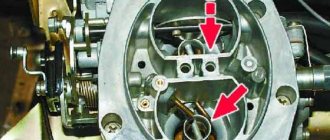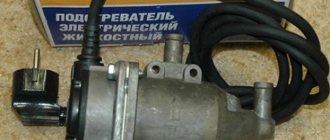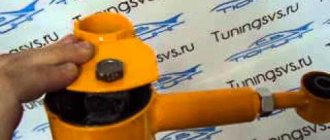How to choose engine heating
Of course, before installing heating, you need to buy it. We will consider two options, one with and without an electric pump. Let's look at the advantages and disadvantages of each of them.
Installation of engine heating on a VAZ 2107 with an electric pump
This preheating differs from the other type by the presence of a pump that circulates the coolant while it is warming up. Naturally, this significantly speeds up the warming up process, however, the circulation of the coolant does not allow it to warm up to the required level.
Advantages:
- as mentioned above, such preheating of the engine warms up the coolant much faster.
- the engine warms up most evenly, which allows you to minimize wear during the first start.
Flaws:
- Perhaps the shortcomings are not as few as we would like. First of all, constant circulation of water requires high power of the heating element. If it is less than 1.5 kilowatts, this may result in the engine simply not warming up to the required temperature. It will just need to be reheated during operation.
- any mechanic will tell you that the fewer parts in a unit, the more reliable it is. An electric pump is installed here, which actually adds a few extra parts. Accordingly, the reliability of such an installation decreases. In addition, installation becomes more complicated.
- additional power supply for the electric pump. The fact is that the pump, as a rule, has a 12 volt power supply. Accordingly, you will have to figure out where to get it. Of course, the first thing that comes to mind is a rechargeable battery, but with this mode of operation it will not last long.
Installing engine heating on a VAZ 2107 without an electric pump
There is a second type, it is the most common because it is easy to install, does not require any maintenance, and is also highly reliable.
Advantages:
- As mentioned above, first of all it is reliability.
- No need for additional power. If you only have a 220 volt outlet, then this is quite enough.
- Easy to install. It is enough to install only a couple of tees and the heated housing itself.
- Low power. Even one kilowatt of electricity is enough.
Flaws:
- Water circulates only under pressure from the temperature difference. That is, when the water has warmed up in the heating housing, it will continue to flow through a small cooling circle.
What is it intended for and how is it designed?
When the engine starts after a long stop, in the first seconds its parts come into contact with each other without lubrication. The viscosity of cold engine oil is higher than in the operating temperature range of the engine. Therefore, it takes some time for the lubricating fluid to penetrate through narrow oil lines to engine parts. Parts of the piston group especially suffer from cold starts. Thus, starting cold motors reduces their service life by up to 1.5 times. In order to avoid this, as well as to make it easier to start the engine in frosty weather, pre-start heaters are designed, powered by a 220 V network.
This device can heat up the engine in 30 minutes even in severe frost
Design and operation of the preheater
A modern heater is designed quite simply and is not much different from a boiler. The principle of its operation is to heat the coolant (antifreeze, antifreeze) to operating temperature, from 60 to 70 °C. When heated, the liquid begins to move through the pipes of the cooling system, heating the engine parts. To speed up heat transfer, many models are equipped with pumps that create pressure in the small circuit of the cooling system.
To create pressure due to temperature differences, heaters without a pump are connected to the cooling system at its lowest point. A device with a pump can be connected to the cooling system anywhere. When the temperature reaches the set value, the relay will simply turn off the heating element. If the temperature drops again, the relay will turn on the antifreeze heating again. Thus, you can connect the device in advance without fear of overheating the coolant.
In addition to heating the engine cooling jacket, heaters can parallel:
- charge batteries;
- pump warm air into the cabin;
- controlled remotely, turning on and off by command from the remote control.
This way you can connect heaters with or without pumps
The power of the heating elements ranges from 500 Watt to 4 kW. The range of additional features depends on the model and complete set of each device. There are also quite simple heaters on sale that are screwed into plugs or drain plugs of engine cooling systems.
Scope of application and variety of models
A simple device and low cost are the main advantages of 220 volt preheaters over other varieties. These devices can be independently installed on any car. You just need to decide on how to mount the device in the engine compartment and follow the manufacturer’s installation instructions. The only condition limiting the scope of application is the mandatory presence of an electrical outlet nearby.
There are models with a remote control on which you can set the heating temperature of the liquid and the heating time of the timer
Such heaters are best suited for private homeowners or car owners living on the lower floors of high-rise buildings. Those who have a nearby garage with electricity will also be happy. After all, an electric heater can be controlled remotely, from a distance of up to 1 kilometer (with direct visibility). If there are obstacles in the signal path, the distance will be significantly reduced.
Today, motorists can purchase preheaters of both Russian and foreign production. Chinese Longfei devices, as well as Norwegian DEFA ones, are popular among motorists. German Webasto heaters are not very convenient due to installation difficulties, and they are also expensive. Among Russian-made products, one can note the Severs and Start trademarks, produced with sets of mounting spare parts for domestic and foreign car models. Each model comes with its own set of mounting parts, along with installation instructions.
Depending on the engine size, you can choose models with power from 1 to 3 kW
Preheater
The problem of difficulty starting the engine in winter is associated with several factors - the viscosity of the oil increases, the resistance in the battery increases, and it cannot produce good starting currents.
As a result, when trying to start, the starter “sluggishly” turns the crankshaft, and the rotation speed is clearly not enough to start the engine. And only after several attempts, when the oil is mixed a little and the battery “warms up”, the engine can still be started, but this does not always happen.
As mentioned above, the difficulty of starting the engine is largely due to the solidification of the working fluids. But if you warm them up before starting, the fluids will become less viscous, and it will be much easier for the starter to turn the crankshaft. It is precisely the preheating of the engine that is the task of the heater.
An engine heater, in principle, is a universal device, so it can be easily installed on a VAZ, UAZ or any other make of car.
Why do you need an antifreeze heater?
“Hmm... If the manufacturer has not provided such a thing as a coolant heater, why is it needed at all? After all, you will probably need to spend a lot of money on it, which is never superfluous!” – most likely half of the drivers think so. And in vain. After all, everyone knows that prevention is better than cure.
. This also applies to the car. Therefore, it is better to install a heater that can operate from a tee (220 volts) or from the car network. With the help of such a device, antifreeze and air in the car interior will be heated in cold weather.
Consequences of antifreeze freezing
rupture and cracking in pipes, hoses and tubes;
damage to the expansion tank;
inability to start the car;
the appearance of cracks on the cylinder heads, which can cause engine failure, resulting in an expensive overhaul.
Now think: do you need all this? "Of course not!" - you will answer and you will be right. To avoid such troubles, we recommend installing an antifreeze heating system. This will help you save your time, money, and most importantly, your nerves
. After all, probably no one wants to find themselves in a situation where real ice appears in the hoses of their car.
Auto catalog
Cars
- VAZ
- UAZ
- GAS
- AZLK
- IZH
- ZAZ
- ZIL
- LuAZ
- RAF
- BYD
- Chevrolet
- Daewoo
- Geely
- Great Wall
- Hyundai
- Lifan
- Tata
Trucks and trailers Autocomponent Plus BelAZ Bryansk Arsenal GAZ ElAZ ZIL KAZ KamAZ KrAZ Madara MAZ MZKT MoAZ NefAZ SZAP Tonar UralAZ ChMZAP BAW DAF DongFeng FAW Foton HOWO Hyundai IVECO JAC Motors MAN Shaanxi Studebaker Tata TATRA Volvo AMAZ Buses Bogdan ZIL KAVZ KAMAZ LAZ LZGMP LiAZ NefAZ PAZ Hyundai Ikarus Karosa Neoplan Tractors and combines Bobruiskagromash BEMZ VgTZ Voronezhselmash VTZ Gomselmash DKZ KZK Kirovets -Landtekhnik Clover Krasnaya Zvezda Lidselmash LTZ Mozyrsky MZ MTZ NefAZ PTZ Sibselmash TeKZ Equipment and service TKZ KZTSH HTZ YuMZ Amity CASE IH Fortschrit t Foton Lemken MacDon TIGARBO Special equipment Truck crane Altailesmash Amkodor AOMZ Atek ATZ Balkankar Record Belovezh Borex Bryansk Arsenal Bulat VEKS GAZ Geomash Gidromash Donex Dormash Dormashina Dorelectromash DEZ Izhneftemash Kanash-Electrocar KZKT KKZ KMZ 1 May KMZ Kovrovets Kommash Kranex KEZ LZA MAZ MZIK MZKM Mikhnevsky RMZ MoAZ MTZ OZP Onezhets Detva Promtractor PTZ Raskat TVEX UVZ Uglichmash UZTM KhTZ ChZKM ChSDM ChTZ EXCO EKSMASH YurMash Chenggong Dimex Doosan Foton H > Engines, gearboxes, fuel injection pumps
Types, features of work
There are several options for such equipment, but in essence such a device is a conventional electric heating element that provides heating of one of the fluids of the power unit.
There are several types of heaters. Some of them heat antifreeze, others heat oil. In the case of coolant, by acting on antifreeze, it is possible to heat the cylinder block, as well as the elements of the power system, which is important for ensuring normal mixture formation.
But such a device has disadvantages:
- it takes more time to warm up the engine, since the cooling system is just a shell of the cylinder block;
- the oil heats up slightly, since it is located below the cooling jacket in the sump, so heat will flow to it only after the cylinder block has been well warmed up;
But when using such a device, there is practically no need to warm up the engine after starting, since it is already heated, and warm air is immediately supplied from the stove to the cabin.
As for heaters that act on oil, such a device only heats the lubricant; the cylinder block and power system remain cold.
Since the volume of oil is small and it is all in one place, it takes little time to warm up. But due to the fact that only the lubricant heats up, after starting it will take time to warm up the motor itself.
In general, the effectiveness of using one or another device is approximately the same. When heating the antifreeze, we get a heated cylinder block and power system, which ensures good mixture formation (the result is excellent flammability of the mixture), but cold oil (the load on the battery and starter will remain high). If you heat the oil, then everything is exactly the opposite - the starter will turn easily, but the unit itself and the power system will remain cold.
Heaters also differ according to the power source used:
- From the network 220 V;
- From the on-board network 12 V (autonomous);
The first option is characterized by high power, and therefore the speed of heating of the working fluid. But to use it, the car must be close to the outlet.
As for autonomous devices, the heating element is powered by a battery, which means you can warm up the liquid anywhere, even in the field. But they are not very powerful, and during operation they drain the battery, and if it is already on the verge of exhausting its life or is simply discharged, then there will simply be no energy left for the starter after warming up.
Antifreeze heaters operating from a 220 V network have become widespread among car owners. In general, this is one of the most optimal options - the battery does not run out, the power of the heating element is high, and after using it, the driver also receives hot air from the stove.
Now manufacturers of automotive accessories and equipment offer different models of preheaters. All of them are almost identical in operating principle, but may differ in design - some consist only of a heating element, while others may additionally have a circulation pump.
The first option is simpler in design, and therefore more reliable. The circulation of liquid in it occurs due to temperature differences. Since the speed of fluid movement in such a device is low, less energy is required to heat the antifreeze passing through the heater.
In a pre-heater with a pump, the heating of the power plant is more uniform due to forced circulation, but in order to heat the liquid well, the power of the heating element must be high. In addition, due to the pump, the likelihood of equipment failure is higher.
Standard carburetor models
Various carburetor models are focused on the environment, reducing consumption or maximizing vehicle dynamics. Carburetors were also created for engines of different sizes. Some models of carburetors from one power unit can be easily installed on another, and in some cases modifications will be required.
Carburetor DAAZ/Weber
DAAZ carburetors (Dmitrov Avtoaggregatny Zavod) 2101, 2103 and 2106 were products that were produced thanks to a license from Weber. For this reason, the models are called both the DAAZ carburetor and the Weber carburetor, but they mean the same device. These carburetor models are characterized by maximum simplicity of design and provide excellent acceleration characteristics.
Carburetor Ozone
Among the disadvantages of this model is the design of the carburetor. The process of active operation leads to a number of problems with the secondary camera. The opening of the chamber does not occur mechanically, but thanks to a pneumatic valve.
Solex carburetor
No less popular is the DAAZ 21053 carburetor model, which is a licensed product from Solex. The carburetor has proven itself to be an economical and at the same time dynamic solution when installed on classic engines. The design of this model is very different from previous DAAZ carburetors. The Solex carburetor has a fuel return system (return). Thanks to this solution, excess gasoline goes back into the gas tank. The return route allows you to save about 400-800 grams of gasoline per hundred kilometers traveled.
Some versions of this model may have a range of auxiliary electronic systems. The main solutions include an idle system with regulation by an electric valve, an automatic cold start system, etc. Such innovations were found on export versions of the car. In the CIS, the Solex carburetor with an electric idle control valve has become widespread.
The system turned out to be problematic in operation. In this type of carburetor, the air and fuel passages are narrow and quickly clog. If the carburetor is not serviced in a timely manner, then the idle system was the first to fail. A Solex carburetor consumes from 6 to 10 liters of fuel in quiet mode. As for dynamics, it is second only to the early development of Weber.
Price list
- Special offers
- KAMAZ spare parts
- Spare parts KAMAZ-5490
- Spare parts MAZ, YaMZ
- ZIL spare parts
- Spare parts ZMZ, for GAZ vehicles
- Spare parts for Volzhanki cars
- Spare parts for Gazelists
- Spare parts for trucks Lawns
- Spare parts for GAZ-71 caterpillar
- Spare parts UAZ, UMZ
- Spare parts KrAZ, BelAZ
- Spare parts URAL
- Spare parts BUSES
- AMAZ spare parts
- IKARUS spare parts
- KAVZ spare parts
- LAZ spare parts
- LIAZ spare parts
- NEFAZ spare parts
- PAZ spare parts
- Other buses
- Tractors, computer equipment, attachments
- Tractors and walk-behind tractors
- Municipal vehicles
- Attachments and trailed equipment
- Spare parts for TRACTORS and SPECIAL EQUIPMENT
- JCB - spare parts for special equipment
- Truck crane (KS-3577, KS-4517, etc.)
- AMZ (A-01, A-41, D-440, D-442, D-447, D-461, D-467)
- Amkodor (TO-18, TO-28, TO-30, etc.)
- ATZ (T-4A, TT-4M)
- VgTZ (DT-75)
- VMTZ (D-120, D-144, D-130, D-145T)
- VTZ (T-25, T30A-80, VTZ-2048)
- LTZ (T-40, LTZ-55, LTZ-60)
- MKSM, UNC, DETVAN
- MTZ - spare parts for tractors
- OTZ (TDT-55)
- PTZ (K-700/701/702/703/704)
- KhTZ (T-150, MT-LB)
- ChTZ (T-130, T-170, B-10, B-12, B-170, T-10M, DET-250)
- YuMZ - spare parts for tractors
- Other special equipment and tractors
- RVD - high pressure hoses and sleeves
- MMZ spare parts and engines
- Spare parts for MMZ engines
- MMZ engines: D-242, D-243, D-245, D-246, D-260
- VAZ spare parts
- Spare parts OKA VAZ 1111
- Spare parts VAZ classic 2101 - 2107
- Spare parts VAZ front wheel drive
- Spare parts VAZ Granta and Largus
- NIVA spare parts and all-wheel drive
- Spare parts Moskvich, IZH
- Spare parts for Korean trucks
- Spare parts for Starex, H-1
- Spare parts for Porter, H-100
- Spare parts for HD65,72,78, County
- Spare parts for HD120, AeroTown
- Spare parts for HD160,170, . ,700,1000
- Spare parts for HYUNDAI, KIA buses
- Spare parts for Korean passenger cars
- Spare parts DAEWOO, CHEVROLET
- FOREIGN CAR spare parts more
- BMW spare parts
- DAF spare parts
- FIAT spare parts
- FORD spare parts
- Spare parts HONDA, ACURA
- IVECO spare parts
- MAN spare parts
- MAZDA parts
- MERCEDES spare parts
- MITSUBISHI spare parts
- Spare parts NISSAN, INFINITI
- OPEL spare parts
- Spare parts PEUGEOT, CITROEN
- RENAULT spare parts
- SCANIA spare parts
- SHAANXI spare parts
- SSANGYONG spare parts
- SUZUKI parts
- Spare parts TOYOTA, LEXUS
- VAG spare parts: VW, AUDI, SEAT, SKODA
- VOLVO spare parts
- Other foreign cars
- Trailers and semi-trailers
- SEMI TRAILERS foreign
- Domestic SEMI-TRAILERS
- TRACTOR TRAILERS
- Passenger TRAILERS
- Towbars and spare parts for passenger trailers
- Car audio and navigation
- Antennas
- DVRs
- Automotive video equipment
- Memory cards, flash drives
- Speakers, subwoofers, acoustics
- Accessories
- Radio tape recorders
- FM modulators, MP3 players
- Navigation, parking systems
- Radar detectors, antiradars
- Radio stations and accessories for them
- Sound amplifiers
- Auto chemical goods, filters
- Car cosmetics, paints, care products
- Auto chemicals, liquids, additives, antifreeze
- Household chemicals, gas
- Oil
- Lubricants, liquid wrenches
- Other means and fuels and lubricants
- Filters and elements
- Rechargeable batteries
- Batteries for motorcycles (up to 30 A/h)
- Batteries for cars (up to 125 A/h)
- Batteries for trucks (from 125 A/h)
- Accessories and tuning
- AvtoLady - products for women
- Breathalyzers
- First aid kits, fire extinguishers, emergency signs
- Car racks
- Gas equipment
- Car mirrors and elements for them
- Air ionizers
- Carpets, trunk mats
- Steering wheels, covers and gear knobs
- Compressors, pumps, hoses
- Seats, cushions, belt adapters
- Literature, catalogs
- Organizers, luggage securing
- Alarms, blockers, sirens
- External tuning
- Tuning internal
- Car refrigerators
- Anti-skid chains
- Seat covers, headrests
- Windshield wiper blades and strips
- Velo, moto, quad bikes
- Bicycles
- ATVs, all-terrain vehicles
- Motorcycles, mopeds, scooters
- Scooters and skateboards
- Accessories for bicycles and motorcycles
- Spare parts, tools for bicycles, motorcycles
- Suits and protection
- Tires, tubes, bicycles, motorcycles
- Helmets and visors
- Electrics for bicycles, motorcycles
- Nuts, bolts, fasteners
- Engines, cabins, frames
- Cylinder blocks
- Engines
- Cabins and bodies
- Platforms and add-ons
- Frames and semi-frames
- Tool, keys
- Chainsaws, generators
- Diagnostics, measurements
- Drills, machines, power tools
- Brushes, rollers, paint sprayers
- Keys, screwdrivers, tools
- Compressor equipment
- Shovels, axes, jacks, cables
- Sinks, vacuum cleaners, brushes
- Grease pumps, syringes, funnels
- Heaters, hair dryers, heat guns
- Pneumatic tools
- Cutting and abrasive tools
- Welding, soldering, gas equipment
- Service equipment
- Construction and finishing equipment
- Tool boxes
- Bearings
- Household goods, souvenirs
- Dacha, recreation, tourism
- Toys, gifts, souvenirs
- Souvenir weapons and pneumatics
- Phones and chargers
- Household goods and life
- Household electrical goods
- Tires, wheels, hubcaps
- Valves, weights, adapters
- Wheel nuts and bolts
- Wheels wheel
- Tubes and rim tapes
- Complete wheels
- Wheel covers
- Tires
- Electrics, devices
- Car lamps, carriers, headlight glasses
- Control units, switches, controllers
- Switches, switches, buttons
- Generators and parts for them
- Sensors, indicators, devices
- Coils, ignition, spark plugs
- Fastening, installation, protection
- Xenon
- Heating, ventilation, cooling, climate
- Washers, windshield wipers, ESP
- Adapters, wires, terminals, connectors
- Fuses, mounting blocks, diodes
- High voltage wires
- Relays, regulators, resistors
- Signals, signs, beacons
- Starters and parts for them
- Headlights, lanterns, reflectors
- Sale of spare parts
- Sale of spare parts for Chevrolet
- Sale of spare parts for Korean cars
All spare parts from A to Z (0 spare parts as of 08/05/2019)
Engine heating installation
In this installation manual, we will look at the Severs M coolant heater, which is embedded in the system and connected to 220 V.
This instruction is also suitable for car models VAZ 2104, VAZ 2105
The heater kit consists of:
- Block with heater;
- Fastening elements;
- Tees, adapters and clamps for insertion into the cooling system;
- Cable with plug.
Additionally, installation may also require pieces of hoses of the required length to make an insert.
There are several installation schemes for such a device, the simplest of which is shown below.
In order for the engine to warm up evenly, antifreeze must be supplied to the heater from the lowest point of the engine, which is the drain plug of the cylinder block. But the exit of the heated liquid is the opposite – to the highest point.
To connect the heater to the VAZ-2107 engine, you must:
- Unscrew the drain plug of the engine cylinder block, open the radiator cap and drain the coolant.
- Apply sealant to the threads of the fitting and screw it in instead of the drain plug
- Secure the bracket to the upper front hole in the cylinder block with a bolt through a spring washer (Fig. below)
- Secure the heater to the front holes in the bracket through the bushings with studs using washers and nuts
- Insert the tee from the kit into the upper hose of the cooling system coming from the radiator. Connect a hose leading to the outlet from the heater block to this tee.
- Route the cable to ensure easy access to the plug.
When installing a heater, you don’t have to drain the antifreeze from the system. If you pre-assemble the heater (connect the hoses, tee and fitting) and quickly install it, then during operation 1-1.5 liters of coolant will leak out, which will then have to be topped up.
After installation, be sure to check all connections for leaks and, if necessary, eliminate them by tightening the clamps.
Installing a heater on a VAZ-2107 injector is no different from that described above.
How to install an antifreeze heater on a VAZ 2107
First of all, it is worth clarifying that the engine heater is installed at the lowest point of the cylinder block. In the classic version, this is a spar to which the beam is screwed. Most manufacturers complete their products with all kinds of brackets; for example, the Alliance heater has a plate that allows you to attach the housing next to the engine to the spar.
Any heater has an indicator arrow, which indicates the point of entry of the coolant into its body. This pipe must be connected to the cylinder block jacket. From here, water will flow into it, after which it will go into the very top pipe, which goes from the radiator to the pump.
As a rule, the kit comes with a special fitting that is screwed in instead of a drain valve or plug installed in the cylinder block. Then the uppermost pipe is cut, after which a special tee, also included in the kit, is inserted into it. It is advisable not to confuse the direction of movement of the coolant, since it is made at a slight angle so that the coolant does not have any obstacles during circulation.
Perhaps this completes the installation of heating on the VAZ 2107 engine. In conclusion, I would like to clarify a few points that may be useful in the future. Quite often in traffic you can come across cars with a fork sticking out from under the hood, from under the bumper, from under the radiator grille or from some other place. This is a little unsightly, so there is a way to hide this detail. For example, you can use a regular connector from a computer power supply. But it must be installed in a place where precipitation will definitely not fall. There are, of course, factory solutions that will help fix this problem. In fact, this is exactly the same connector, which simply has a rubber plug.
Another convenient addition is an outlet with a timer. There is no need to explain the principle of its operation, it will simply help control the heating time. Of course, most engine heaters have thermostats that turn it off, but this is more convenient and reliable. So, in this article we looked in detail at how to install an antifreeze heater on a VAZ 2107 car. Below is a video that clearly demonstrates the process of installing this additional unit on a car.
Heater device
- Ball valve - ensures directed circulation of elevated fluid temperature through the heater into the engine cooling system.
- Thermostat – ensures optimal engine warm-up, does not allow the heater to heat above the set temperature, which protects the device from overheating and saves energy.
- The drain plug is an optional feature that provides easy access to drain coolant through the heater drain hole on 2.0 and 3.0 kW heaters only.
Installation
Before installing antifreeze heating, be sure to check the entire cooling system. If you find any faults in it or places where there are cracks or tears, repair everything. Also, if you see sediment or any foreign impurities in the antifreeze, replace the liquid.
Note that for pre-start heating of the engine, the electric heater must be installed strictly horizontally, with its outlet openings directed upward. To do this, you will need clamps and a mounting kit.
Winter heating of the VAZ 2107 engine
And again it’s winter outside. I don’t know about you, but where I live, frosts are below thirty or more. My deepest sympathy for those who already get the greatest pleasure from dancing with a tambourine in the morning, starting their car in the yard in the cold. But I enjoy it. I don't enjoy it that much. Pun intended though. I'll tell you why this is so.
In the fall, when I went to a car repair shop to look for a front gearbox for an old Niva, I bought this interesting thing from a guy. It's called a starting heater. It was lying among a pile of old spare parts, and the man himself didn’t know what kind of thing it was, so he gave it to me for 100 rubles.
There was nothing written on the thing, but when I washed it, I read the inscription that “power 1500 W.” Inside the thing was a TEN, a ball with a spring (apparently a valve) and a 90-degree thermal contact.
I later found a beautiful picture and description of this device on the Internet. It turned out that this thing is a Pre-Starting Heater, it comes from Tyumen, its name is “Alliance” and they make such things for almost all brands of passenger cars.
I decided not to put it off for long, but to quickly install the thing on the car, before it snowed outside and it was near zero. Due to the fact that I only got a heater, to install it I needed the following
:
1. Actually, the heater itself, cleaned and washed 2. Pump from a Gazelle stove 3. Power supply from a broken laptop 4. Hoses for the AM Moskvich stove, 2 pieces of 2 m each 5. Small-sized half-inch tap, with external thread (male) 6 Three fittings for a 20 mm hose with internal thread (female) 7. Tee 32mm - 32mm - 12 inches 8. Worm clamps, automotive, 40, 30, 25 mm 9. 220 V wire with plug 10. FUM plumbing tape. 11. Silicone auto sealant
I unscrewed this bolt, drained the antifreeze, and measured it. It turned out to be an M10 X1 thread. I picked up a pipe with such a thread in the garage among all the rubbish. A tube fits for fastening a light bulb socket in an old floor lamp. I sawed off the required piece and put a hose with a clamp on it. I screwed the fitting onto the sealant into the block directly with the hose.
Installing the tee into the cut in the upper radiator hose was much easier. The tee, fitting, sealant, clamps and FUM tape did an excellent job of this.
Receive a selection of new homemade products by email. No spam, only useful ideas!
*By filling out the form you agree to the processing of personal data
Installation
Before installing antifreeze heating, be sure to check the entire cooling system. If you find any faults in it or places where there are cracks or tears, repair everything. Also, if you see sediment or any foreign impurities in the antifreeze, replace the liquid.
Note that for pre-start heating of the engine, the electric heater must be installed strictly horizontally, with its outlet openings directed upward. To do this, you will need clamps and a mounting kit.
Mount the heater slightly lower than the minimum antifreeze level mark. In this case, the liquid will circulate well. If it is not possible to install it low, connect the heater to the radiator pipe at the bottom. Connect the motor tube to the input of the device that will heat the motor. And connect the heater output at the highest point, but not higher than the level of the engine thermostat. You can use the so-called shirt space
.
Important
when installing the heater, make sure that the place where the device is connected to the motor is higher at the output than at the input;
Do not allow loops in the hose that goes to the engine to appear - this contributes to the formation of air pockets, and they impair the passage of antifreeze.
We briefly talked about why and how you need to install an antifreeze heater on a VAZ 2107. If you doubt that you can handle it on your own, contact a specialist.
RECOMMENDATIONS FOR INSTALLATION OF ELECTRIC ENGINE HEATER Severs 1.5 kW 220 V ON VAZ-2101…2107, Niva CARS
GENERAL INSTRUCTIONS
This installation manual serves to ensure the installation of the SEVERS heater and its modifications, hereinafter referred to as the “heater”, on VAZ-2101...2107, Niva cars when using installation kit No. 1. In this installation scheme, where the hot water supply coolant from the heater outlet pipe is carried out through a tee into the upper radiator hose, it is necessary to constantly monitor the liquid level in the expansion tank.
RECOMMENDATIONS FOR HEATER INSTALLATION
2. Preparing the heater for installation Cut the rubber hose into lengths: first of all (inlet hose) L 1 = 140 mm; remainder (outlet sleeve) L 2 = 460 mm. Secure the bracket to the heater with studs (bolts) using washers and nuts (Fig. 1).
Place the sleeves on the corresponding heater pipes and secure the connections with clamps.
3. Preparing the car engine Unscrew the drain plug of the engine cylinder block, open the radiator cap and drain the coolant. Clean the hole in the block for the drain plug.
4. Installation of the K1/8″ fitting Apply sealant to the thread of the fitting, or seal it with tape. Instead of the drain plug, screw in the K1/8″ fitting (Fig. 2).
5. Installation of the heater Secure the bracket with the heater with a bolt through washer 10 and the spring washer from the kit (Fig. 2). Place the clamp on the inlet sleeve. Place the inlet hose onto the K1/8″ fitting and secure the connection with a clamp.
ATTENTION! The heater must not touch the fuel hose or the fine fuel filter housing.
Select the length of the fuel hoses and the position of the filter.
6. Installation of a 32x16 tee. Cut the upper radiator hose: – on VAZ-2101...2107 in accordance with Fig. 3;
– on a Niva with an injection engine in accordance with Fig. 4.
On a Niva with a carburetor engine, the outlet hose should pass next to the distributor, as in Fig. 3. In the place where the upper radiator hose is cut, cut off 20 mm from the edge at one of the remaining sections, ensuring the correct location of the outlet hose (Fig. 3, 4). Place clamps on the sections of the upper radiator hose and install a 32x16 tee in the cut, with the side fitting directed away from the engine and towards the heater.
7. Connection of the heater to the engine cooling system. Place the clamp on the outlet hose. Place the outlet sleeve on the side fitting of the tee and secure the connection with a clamp. By turning the tee, achieve the most correct position of the outlet sleeve. Tighten the clamps on the radiator hose. Fill the cooling system through the radiator filler neck.
8. Fixing the power cable The power cable should be laid and secured with ties or in another way that ensures the safety of the wire from mechanical damage, so as to prevent the possibility of its contact with moving and heated parts of the engine. For heaters that have a detachable connection on the power cable, it is necessary to connect the connectors and securely fix (see above) sections of the wire near this connection to prevent disconnection during vehicle operation.
9. Final operation Check connections for coolant leaks and repair if any. Close the radiator cap. Start the engine for 3-5 minutes, and after stopping the engine, add coolant to the required level.
Security measures
Finally, a little about the safety rules when using such a preheater:
- Do not leave the equipment turned on for a long period of time. For normal warming up of the engine, 1-1.5 hours is enough;
- If an extension cord is used for connection, its wires must have a cross-section appropriate for the load;
- If the equipment is used on a car parked on the street, you need to mark or fence off the area through which the power cable runs.
For ease of use of the device, it should be connected to a power outlet through an adapter with a timer, on which you can set the time for turning the heater on and off.
Related articles:
- Description and installation of the Longfey heater
- Description and installation of the Alliance heater
- Description and installation of the heater Start
- Homemade pre-heater for a VAZ car engine
Trade marks
Depending on the volume of your orders per month, we offer our clients the following prices:
Wholesale 1. – for orders from 70,000 to 170,000 rubles. Wholesale 2. – for orders from 170,000 to 400,000 rubles. Wholesale 3. – for orders over 400,000 rubles. Wholesale 4. – VIP price for individual contracts. Retail - Price for retail sales and small single purchases.
All prices are indicated including VAT in Russian rubles. You see prices according to your access level.
Do you have a VAZ 2107 car, and have you already had to deal with the fact that the antifreeze in the cooling system froze when there was severe frost outside? Then installing an antifreeze heater on a VAZ 2107 injector would be very useful in your case. For information on how to install an antifreeze heater, read the article below.
Main technical characteristics and design features
- Power 1.5, 2.0, 3.0 kW
- Rated voltage 220V
- Cord length – 120 cm.
- Type of current – alternating
- Current frequency 50 Hz
- Anodized aluminum housing
- Hermetically sealed housing design with an electric heating element completely eliminates the ingress of coolant into the electrical part
- Thermostat (operation temperature 95°C (not lower)
- Small dimensions allow the heater to be conveniently placed in the engine compartment.
Why is it more profitable to use 220-volt devices?
Now let's talk about the benefits. The first reason why these antifreeze heaters are purchased (that is, those that operate on a 220 V network) is their low price and reliability. But the most important thing why motorists appreciate such a device is its simplicity and ease of installation. It is much easier to install it and connect it to the system than a similar device powered by the car’s on-board network. In addition, such a device will warm up the interior and charge the battery, while the on-board heater will only discharge it with its heating element.
If your car has a device such as an antifreeze heater (VAZ 2110 included), it will always be in a warm state, so you will not waste your time and nerves on heating the engine in severe frost. After a few minutes of operation of this heater, you will not only have a warm engine, but also a warm interior. But each of us knows firsthand what it’s like to get into a cold car in the cold. At -20 degrees, the cold penetrates right to the bones, and the barely working stove is slowly just starting to supply warm air. In addition to this, there are icy windows, which are almost impossible to get rid of ice... In general, the picture is not the best, especially for owners of VAZs, in which not only the noise reduction is poor, but also the stove. With a heater, you will always sit in a warm interior and will not have to worry about peeling off frozen pieces of ice from the outside of the glass.
Why do you need an antifreeze heater?
“Hmm... If the manufacturer has not provided such a thing as a coolant heater, why is it needed at all? After all, you will probably need to spend a lot of money on it, which is never superfluous!” – most likely half of the drivers think so. And in vain. After all, everyone knows that prevention is better than cure.
. This also applies to the car. Therefore, it is better to install a heater that can operate from a tee (220 volts) or from the car network. With the help of such a device, antifreeze and air in the car interior will be heated in cold weather.
Consequences of antifreeze freezing
rupture and cracking in pipes, hoses and tubes;
damage to the expansion tank;
inability to start the car;
the appearance of cracks on the cylinder heads, which can cause engine failure, resulting in an expensive overhaul.
Now think: do you need all this? "Of course not!" - you will answer and you will be right. To avoid such troubles, we recommend installing an antifreeze heating system. This will help you save your time, money, and most importantly, your nerves
. After all, probably no one wants to find themselves in a situation where real ice appears in the hoses of their car.
P O P U L A R N O E:
For those who don’t have time to “bother” with all the nuances of charging a car battery, monitoring the charging current, turning it off in time so as not to overcharge, etc., we can recommend a simple car battery charging scheme with automatic shutdown when the battery is fully charged. This circuit uses one low-power transistor to determine the voltage on the battery.
In many modern cars, windshield wipers operate in different modes - continuous and pulsating (there is a pause between sweeps of the blades). This mode is very convenient in light rain and drizzle, but it’s a pity not all cars have it. Some cars with basic equipment do not have it. The question arises: how to equip your car with this mode? Read more…
How to protect the body of your car from corrosion without overpaying a car mechanic.
Since I am an avid motorist, I am interested in everything related to cars. Every car owner is faced with the task of protecting the car body from corrosion. I had read about this original method before; back at the beginning of the last century it was used to protect ship hulls. But this is the first time I have encountered the commercial application of such a miracle technology. While reading advertisements in newspapers, I came across an advertisement for “Electrochemical protection of the car body against corrosion.” After reading the short article, I decided to find out more in the car service center itself. Read more…
Source











